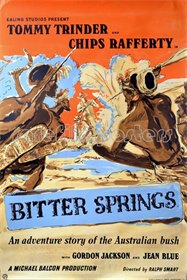Bitter Springs (film)
| Bitter Springs | |
|---|---|

British poster by Robert Medley
|
|
| Directed by | Ralph Smart |
| Produced by |
Michael Balcon Leslie Norman (assoc) |
| Written by |
Monja Danischewsky W. P. Lipscomb |
| Based on | a story by Ralph Smart |
| Starring |
Tommy Trinder Chips Rafferty Gordon Jackson |
| Music by | Ralph Vaughan Williams |
| Cinematography | George Heath |
| Edited by | Bernard Gribble |
|
Production
company |
|
|
Release date
|
|
| Country | Australia United Kingdom |
| Language | English |
| Budget | £100,000 |
Bitter Springs is an Australian–British film directed by Ralph Smart and released in 1950. An Australian pioneer family leases a piece of land from the government in the Australian outback in 1900 and hires two inexperienced British men as drovers. Problems with local Aboriginal people arise over the possession of a waterhole. Much of the film was shot on location in the Flinders Ranges in South Australia
In the early 1900s, Wally King travels 600 miles to outback South Australia to occupy land he has leased from the government. He is accompanied by his wife Ma, children Emma and John, and friends Tommy and Mac. Despite warnings from a local trooper, the bigoted King clashes with an Aboriginal tribe who depend on water located on what has become the family's property.
Relations with the local Aboriginal people deteriorate to the point where John King is speared. The Kings are in danger of being killed by a raiding party but they are rescued by the trooper and his men. A compromise is reached where the Kings agree to work with the Aboriginal people running a sheep station.
The film was the idea of Ralph Smart and roughly based on an apparently true story. This was the third movie Ealing Studios made in Australia following the success of The Overlanders (1946). It was originally announced as a comedy starring Rafferty and Trinder, and was meant to be followed by a version of Robbery Under Arms.
Tommy Trinder's part was created especially for him to ensure the movie had some comic relief. Nick Yardley had previously appeared in Ralph Smart's Bush Christmas. Nonnie Piper was a 19-year-old model.
The original script ended with the massacre of Aboriginal people at the hands of the white settlers, but this was changed at the insistence of Ealing Studios.
Ralph Smart scouted around Australia for locations and at one stage it seemed that the film would be made in Murgon, Queensland but eventually it was decided to make it in South Australia.
Writer Dave Moore flew out to Australia to help with the script.
Filming started in May 1949. Location shooting was completed in November, nearly two months behind schedule due to rain delays, and was followed by two weeks at Pagewood Studios in Sydney.
...
Wikipedia
